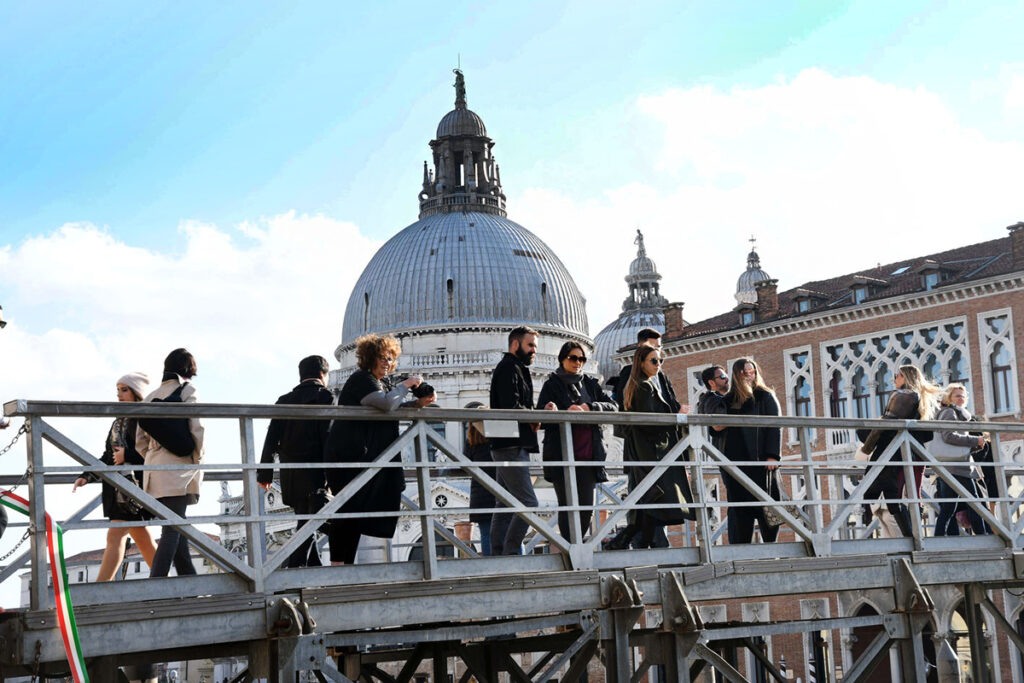
The Feast of the
Madonna of Health
in Venice!
Santa Maria della Salute (also known as the Church of Health, or simply La Salute) is a beautiful basilica erected near Punta della Dogana.
It is an ex-voto to the Madonna by the Venetians for their deliverance from the plague that, between 1630 and 1631, decimated the population, as had happened previously with the churches of the Redeemer and of Saint Roch.

The plague was brought to Venice by an ambassador of the Count of Mantua, who was promptly isolated in the Lazzaretto Vecchio. Unfortunately, he had already come into contact with a carpenter, thus infecting the entire city, starting from Campo San Lio.
On October 22, 1630, Patriarch Giovanni Tiepolo uttered these words: ‘Solemn vow to erect and dedicate a Church in this City to the Most Holy Virgin, naming it SANTA MARIA DELLA SALUTE, and that every year on the day when this City is declared free from this current affliction, His Serenity and His Successors shall solemnly visit the same Church with the Senate in perpetual memory of the Public gratitude for such a great blessing.
Contact us!
Whether it’s for information or to book your stay, feel free to write to us or call us at +39 0421 381223.
The Prayer of the Venetians

On October 26 in St. Mark’s Square, Doge Nicolo’ Contarini, the entire clergy, and the Venetian people gathered to pray.
When the plague finally passed, 80,000 Venetians had died, and 600,000 across the territory of the Serenissima, from Brescia to Trieste, from the Polesine to Belluno.
Among the deceased were the Doge and the Patriarch.
To make space for the new church, a nearby religious complex, the Church of the Most Holy Trinity with its convent and school, adjacent to Punta da Mar where the Venice customs house is located, was decided to be demolished.
In order to erect the Basilica in that place, a total of 1,156,650 piles were driven into the ground, and extensive land reclamation was carried out.
On November 28, 1631, the first pilgrimage of thanksgiving took place.
The Festival, in Venice!
The feast of Madonna della Salute takes place on November 21, the day of the Presentation of the Blessed Virgin Mary, and to this day is celebrated spontaneously in the city of Venice, in Trieste, and in many cities and towns of the former Republic, in Italy, Istria, and Dalmatia.
The Serenissima Republic, in fact, to enable populations distant from the capital to observe the Feast, promoted the construction of sanctuaries dedicated to Madonna della Salute throughout the Republic, which are still numerous today, even in small villages. Many of these sanctuaries, like in Venice, are still pilgrimage destinations on November 21.
To stay in Jesolo (Venice) during the festivities of Madonna della Salute in Venice, choose and book at Hotel Germania!
www.hotelgermania.net
Phone: +39 0421 381223
E-Mail: info@hotelgermania.net
Pilgrimage
to the Basilica
of Health
In Venice, the pilgrimage leads to the Basilica of Santa Maria della Salute.
Throughout the day, the basilica remains open without interruption, hosting continuous masses and rosaries with a continuous influx of worshippers.
To facilitate the pilgrimage, a temporary wooden bridge is set up over the Grand Canal, connecting from Santa Maria del Giglio to the vicinity of the basilica.
In the city of Venice, November 21 is still a public holiday for civil purposes, thanks to a fortunate coincidence: the feast day of Venice’s patron saint, Saint Mark, falls on April 25, the day Italy celebrates Liberation. In such cases, the law allows the municipality to choose another day to enjoy the patronal festival, and the Municipality of Venice has chosen… the day of Madonna della Salute.

The religious rituals
during the festival
It’s always a profound experience to ascend the steps of the Basilica della Salute and enter Longhena’s Baroque masterpiece to light a candle, honoring the Virgin with one’s own vow, and seeking her intercession for health.
Throughout the day, masses are celebrated every hour in the Basilica della Salute, and in the morning, one of them is presided over directly by the Patriarch of Venice.
In the afternoon, there is a musical tribute to the Madonna, and the evening concludes with the Celebration of Compline (the evening prayer).

Even though the religious aspect is predominant in this celebration, over the years, numerous initiatives have emerged, particularly developing the festive aspect of the event: various candy stalls and colorful balloons enliven the day of Salute, making it a memorable event especially for the youngest visitors, our children!
The art and history
of the Basilica
of Health
At the center of the main altar lies the venerated image of Mary of Health: the medieval painting revered by Venetians as it was acknowledged to have interceded with Christ to end the plague.
The artwork originated from the island of Crete, arriving in Venice on February 26, 1670, along with the great Sea Captain (and later Doge) Francesco Morosini.
After resisting the Turks for 21 years while defending the last Venetian-held city in Crete, Candia, Morosini finally decided to make peace with the enemy, managing to leave the city with the Icon from the Church of San Tito, the Madonna that was placed on the altar at the Salute.

The Candiotti referred to her as the Madonna of San Tito or Mesopanditissa, acknowledging her role as a mediator of peace, credited with ending the conflict in 1264 that had opposed Venetians and Candiotti for over 60 years.
Therefore, the image had been the protector of Candia for centuries.
Sea Captain Morosini returned from Candia to Venice, entering the lagoon on February 26, 1670, with the image of the Madonna of San Tito hoisted on the mainmast of his ship.
On November 21, 1670, the canvas of the Madonna of Health was affixed above the main altar of the new temple, finally inaugurating the Feast of Health of the Republic of Venice!

The Painting of the Madonna of the Feast of Health depicts a Virgin in a purple robe and an amber-colored face with a serious expression, presenting the Baby Jesus in her arms to the pilgrim.
The Baby Jesus holds the Scroll of Revelation in one hand and blesses the believer with the other.
I Veneziani, before proceeding towards the main altar, usually stop at the center of the basilica where in the floor, there is a roundel that bears the Latin inscription UNDE ORIGO – INDE SALUS and the date MDCXXXI.
It is believed that this gesture is a good omen for the realization of intercession for one’s health.
The inscription can be translated as ‘From where (comes) the origin, from there (comes) the salvation.
The Votive Bridge over
the Grand Canal for the
Feast of Health
Every year, the Municipality entrusts Insula – responsible for the construction of the votive bridges for the Redentore and San Michele festivals – to build a temporary bridge for the Feast of Health. This bridge is placed over boats, connecting the two banks of the Grand Canal from S. Maria del Giglio (in the district of San Marco) to the opposite bank of Dorsoduro.
The bridge remains set up temporarily for a few days, allowing thousands of worshippers and visitors to make a pilgrimage to the Basilica of Health, paying homage to the Madonna and traditionally lighting a candle to seek the intercession of the Virgin for improved health.








